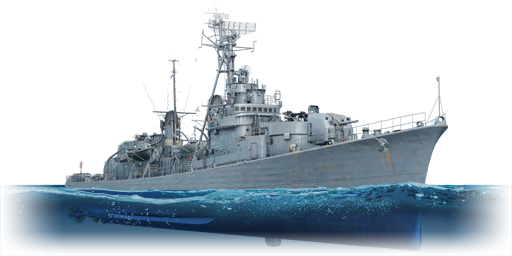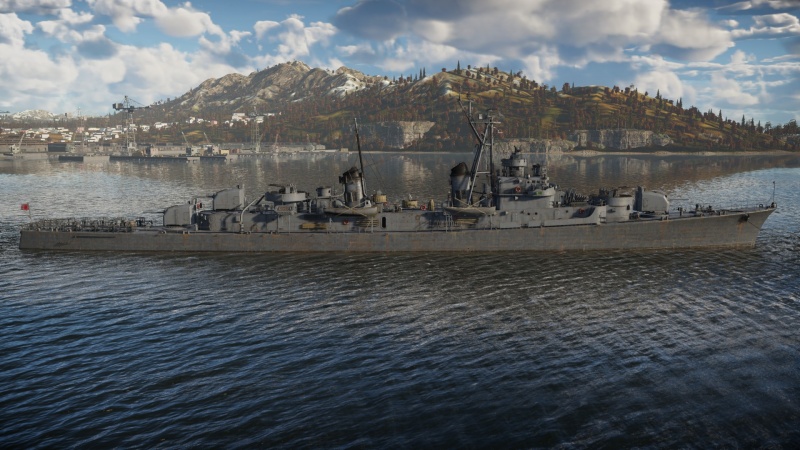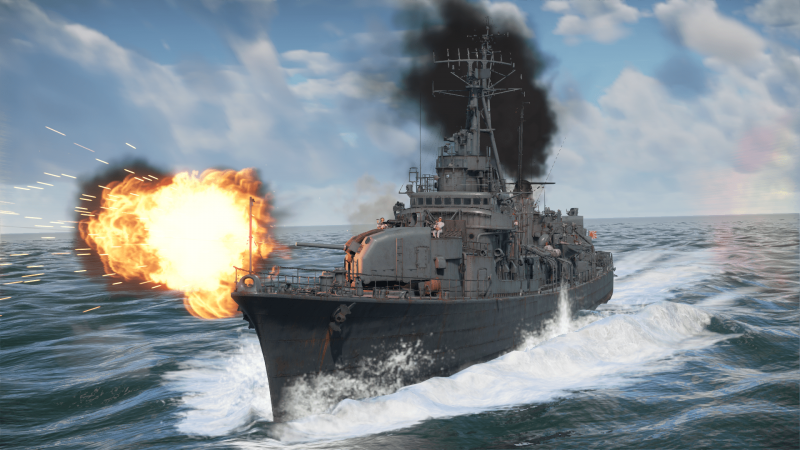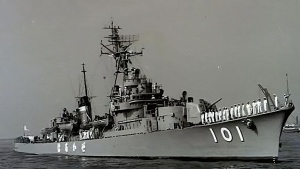Difference between revisions of "JDS Harukaze (DD-101)"
(→History) |
(Edits) |
||
| Line 19: | Line 19: | ||
{{Specs-Fleet-Mobility}} | {{Specs-Fleet-Mobility}} | ||
<!-- ''Write about the ship's mobility. Evaluate its power and manoeuvrability, rudder rerouting speed, stopping speed at full tilt, with its maximum forward and reverse speed.'' --> | <!-- ''Write about the ship's mobility. Evaluate its power and manoeuvrability, rudder rerouting speed, stopping speed at full tilt, with its maximum forward and reverse speed.'' --> | ||
| − | + | Lacking speed in comparison to other destroyers due to the difference of role, while most destroyers are general purpose destroyers for open sea, the Harukaze was built for ASW and coastal defense and this reflects in her top speed of 30 kn. | |
{{NavalMobility}} | {{NavalMobility}} | ||
| Line 33: | Line 33: | ||
{{main|5 inch/38 Mk.12 (127 mm)}} | {{main|5 inch/38 Mk.12 (127 mm)}} | ||
| − | + | The Harukaze will move away from the Japanese playstyle of torpedo-centric doctrine, even more so that the Harukaze doesn't even have a single torpedo launch tube. Equipped with American 5 inchers, she will have a much stronger gunplay compared to IJN ships due to lightweight shells, quick-loading breaches and AP shells. This does mean she lays closer to playstyle to USN ships, but only comes with 3 single-cannon turrets. | |
| + | {| class="wikitable sortable" style="text-align:center" width="100%" | ||
| + | ! colspan="8" | Penetration statistics | ||
| + | |- | ||
| + | ! rowspan="2" data-sort-type="text" | Ammunition | ||
| + | ! rowspan="2" | Type of<br>warhead | ||
| + | ! colspan="6" | Penetration @ 0° Angle of Attack (mm) | ||
| + | |- | ||
| + | ! 1,000 m !! 2,500 m !! 5,000 m !! 7,500 m !! 10,000 m !! 15,000 m | ||
| + | |- | ||
| + | | AAC Mk.34 || HE || 36 || 36 || 36 || 36 || 36 || 36 | ||
| + | |- | ||
| + | | Common Mk.32 || Common || 124 || 103 || 77 || 58 || 46 || 37 | ||
| + | |- | ||
| + | | SP Common Mk.46 || SP Common || 150 || 125 || 93 || 71 || 56 || 45 | ||
| + | |- | ||
| + | | AAVT Mk.31 || HE-VT || 36 || 36 || 36 || 36 || 36 || 36 | ||
| + | |- | ||
| + | |} | ||
| + | {| class="wikitable sortable" style="text-align:center" width="100%" | ||
| + | ! colspan="10" | Shell details | ||
| + | |- | ||
| + | ! rowspan="2" data-sort-type="text" | Ammunition | ||
| + | ! rowspan="2" | Type of<br>warhead | ||
| + | ! rowspan="2" | Velocity<br>(m/s) | ||
| + | ! rowspan="2" | Projectile<br>mass (kg) | ||
| + | ! rowspan="2" | Fuse delay<br>(s) | ||
| + | ! rowspan="2" | Fuse sensitivity<br>(mm) | ||
| + | ! rowspan="2" | Explosive mass<br>(TNT equivalent) (g) | ||
| + | ! colspan="3" | Ricochet | ||
| + | |- | ||
| + | ! 0% !! 50% !! 100% | ||
| + | |- | ||
| + | | AAC Mk.34 || HE || 792 || 25 || 0 || 0.1 || 3,220 || 79° || 80° || 81° | ||
| + | |- | ||
| + | | Common Mk.32 || Common || 792 || 24.49 || 0.01 || 6 || 1,150 || 47° || 60° || 65° | ||
| + | |- | ||
| + | | SP Common Mk.46 || SP Common || 792 || 25 || 0.01 || 6 || 906.5 || 48° || 63° || 71° | ||
| + | |- | ||
| + | |} | ||
| + | {| class="wikitable" style="text-align:center" width="100%" | ||
| + | ! colspan="12" | Proximity-fused shell details | ||
| + | |- | ||
| + | ! rowspan="2" data-sort-type="text" | Ammunition | ||
| + | ! rowspan="2" | Type of<br>warhead | ||
| + | ! rowspan="2" | Velocity<br>(m/s) | ||
| + | ! rowspan="2" | Projectile<br>mass (kg) | ||
| + | ! rowspan="2" | Fuse delay<br>(m) | ||
| + | ! rowspan="2" | Fuse sensitivity<br>(mm) | ||
| + | ! rowspan="2" | Arming distance<br>(m) | ||
| + | ! rowspan="2" | Trigger radius<br>(m) | ||
| + | ! rowspan="2" | Explosive mass<br>(TNT equivalent) (g) | ||
| + | ! colspan="3" | Ricochet | ||
| + | |- | ||
| + | ! 0% !! 50% !! 100% | ||
| + | |- | ||
| + | | AAVT Mk.31 || HE-VT || 792 || 25 || 0 || 0.1 || 457 || 23 || 3,220 || 79° || 80° || 81° | ||
| + | |- | ||
| + | |} | ||
=== Secondary armament === | === Secondary armament === | ||
{{Specs-Fleet-Secondary}} | {{Specs-Fleet-Secondary}} | ||
| Line 41: | Line 99: | ||
''Some ships are fitted with weapons of various calibres. Secondary armaments are defined as weapons chosen with the control <code>Select secondary weapon</code>. Evaluate the secondary armaments and give advice on how to use them. Describe the ammunition available for the secondary armament. Provide recommendations on how to use them and which ammunition to choose. Remember that any anti-air armament, even heavy calibre weapons, belong in the next section. If there is no secondary armament, remove this section.'' | ''Some ships are fitted with weapons of various calibres. Secondary armaments are defined as weapons chosen with the control <code>Select secondary weapon</code>. Evaluate the secondary armaments and give advice on how to use them. Describe the ammunition available for the secondary armament. Provide recommendations on how to use them and which ammunition to choose. Remember that any anti-air armament, even heavy calibre weapons, belong in the next section. If there is no secondary armament, remove this section.'' | ||
| + | |||
| + | {| class="wikitable sortable" style="text-align:center" width="100%" | ||
| + | ! colspan="8" | Penetration statistics | ||
| + | |- | ||
| + | ! rowspan="2" data-sort-type="text" | Ammunition | ||
| + | ! rowspan="2" | Type of<br>warhead | ||
| + | ! colspan="6" | Penetration @ 0° Angle of Attack (mm) | ||
| + | |- | ||
| + | ! 10 m !! 100 m !! 500 m !! 1,000 m !! 1,500 m !! 2,000 m | ||
| + | |- | ||
| + | | 40 mm HEFI-T || HEFI-T || 3 || 3 || 3 || 3 || 3 || 3 | ||
| + | |- | ||
| + | | 40 mm AP-T || AP-T || 81 || 78 || 68 || 58 || 49 || 41 | ||
| + | |- | ||
| + | |} | ||
| + | {| class="wikitable sortable" style="text-align:center" width="100%" | ||
| + | ! colspan="10" | Shell details | ||
| + | |- | ||
| + | ! rowspan="2" data-sort-type="text" | Ammunition | ||
| + | ! rowspan="2" | Type of<br>warhead | ||
| + | ! rowspan="2" | Velocity<br>(m/s) | ||
| + | ! rowspan="2" | Projectile<br>mass (kg) | ||
| + | ! rowspan="2" | Fuse delay<br>(m) | ||
| + | ! rowspan="2" | Fuse sensitivity<br>(mm) | ||
| + | ! rowspan="2" | Explosive mass<br>(TNT equivalent) (g) | ||
| + | ! colspan="3" | Ricochet | ||
| + | |- | ||
| + | ! 0% !! 50% !! 100% | ||
| + | |- | ||
| + | | 40 mm HEFI-T || HEFI-T || 874 || 0.9 || 0 || 0.1 || 67.13 || 79° || 80° || 81° | ||
| + | |- | ||
| + | | 40 mm AP-T || AP-T || 874 || 0.89 || N/A || N/A || N/A || 47° || 60° || 65° | ||
| + | |} | ||
=== Additional armament === | === Additional armament === | ||
| Line 71: | Line 162: | ||
<!-- ''Describe the history of the creation and combat usage of the ship in more detail than in the introduction. If the historical reference turns out to be too long, take it to a separate article, taking a link to the article about the ship and adding a block "/History" (example: <nowiki>https://wiki.warthunder.com/(Ship-name)/History</nowiki>) and add a link to it here using the <code>main</code> template. Be sure to reference text and sources by using <code><nowiki><ref></ref></nowiki></code>, as well as adding them at the end of the article with <code><nowiki><references /></nowiki></code>. This section may also include the ship's dev blog entry (if applicable) and the in-game encyclopedia description (under <code><nowiki>=== In-game description ===</nowiki></code>, also if applicable).'' --> | <!-- ''Describe the history of the creation and combat usage of the ship in more detail than in the introduction. If the historical reference turns out to be too long, take it to a separate article, taking a link to the article about the ship and adding a block "/History" (example: <nowiki>https://wiki.warthunder.com/(Ship-name)/History</nowiki>) and add a link to it here using the <code>main</code> template. Be sure to reference text and sources by using <code><nowiki><ref></ref></nowiki></code>, as well as adding them at the end of the article with <code><nowiki><references /></nowiki></code>. This section may also include the ship's dev blog entry (if applicable) and the in-game encyclopedia description (under <code><nowiki>=== In-game description ===</nowiki></code>, also if applicable).'' --> | ||
[[File:JDS Harukaze Historical.jpeg|thumb|The JDS Harukaze during a ceremony.]] | [[File:JDS Harukaze Historical.jpeg|thumb|The JDS Harukaze during a ceremony.]] | ||
| − | JDS Harukaze (はるかぜ, [[Abbreviations#.28JP.29_Naval|namesake]]: Spring Wind) was the lead ship of the Harukaze-class and the first domestically built ship after the war. | + | JDS Harukaze (はるかぜ, [[Abbreviations#.28JP.29_Naval|namesake]]: Spring Wind) was the lead ship of the Harukaze-class and the first domestically built ship after the war. The main design purpose of the Harukaze, like all Japanese post-war vessels, is coastal defence and ASW focus in defence of Japanese waters. |
| + | |||
| + | Inspired by ships from the war, the Harukaze-class mainly took design advantage from the USS Gearing-class in overall construction and equipment, with traverse taken from Imperial Japanese designs; [Yudachi[|Shirayatsuyu]]- and Asashio-class. | ||
While laid down at the Mitsubishi shipyard in Nagasaki on 15 December 1954 with hull pennant DD-101, outfitted equipment was mostly if not all supplied by the United States according to the US and Japan Mutual Defense Assistance Agreement. Harukaze (DD-101) and her sister ship Yukikaze (DD-102) both were built with the main role of anti-submarine warfare (ASW). | While laid down at the Mitsubishi shipyard in Nagasaki on 15 December 1954 with hull pennant DD-101, outfitted equipment was mostly if not all supplied by the United States according to the US and Japan Mutual Defense Assistance Agreement. Harukaze (DD-101) and her sister ship Yukikaze (DD-102) both were built with the main role of anti-submarine warfare (ASW). | ||
Revision as of 23:54, 31 December 2022
Contents
Description
The Harukaze-class, JDS Harukaze (DD 101), 1956 (はるかぜ, namesake: Spring Wind) is a rank II Japanese destroyer with a battle rating of 4.0 (AB/RB/SB). It was introduced in Update "Winged Lions".
The first destroyer class made in Japan after WW2, the JDS Harukaze resembles American destroyers more than its IJN predecessors. It is armed with 3 fast-firing single 127 mm guns with a variety of shells, including HE-VT to take down aircraft, which is also added to with a good AA battery of 2 quad-mount 40 mm Bofors cannons. However, Harukaze lacks torpedoes of any kind, which prevents it from reliably taking down large ships. Compared to other destroyers, Harukaze is relatively slow, having a max speed of only 56 km/h. In many ways, Harukaze is like a larger version of the JDS frigates Akebono and Ikazuchi, having fast-firing dual-purpose guns, a somewhat slow speed, and a secondary armament of only depth charges.
General info
Survivability and armour
Talk about the vehicle's armour. Note the most well-defended and most vulnerable zones, e.g. the ammo magazine. Evaluate the composition of components and assemblies responsible for movement and manoeuvrability. Evaluate the survivability of the primary and secondary armaments separately. Don't forget to mention the size of the crew, which plays an important role in fleet mechanics. Save tips on preserving survivability for the "Usage in battles" section. If necessary, use a graphical template to show the most well-protected or most vulnerable points in the armour.
Mobility
Lacking speed in comparison to other destroyers due to the difference of role, while most destroyers are general purpose destroyers for open sea, the Harukaze was built for ASW and coastal defense and this reflects in her top speed of 30 kn.
| Mobility Characteristics | |||
|---|---|---|---|
| Game Mode | Upgrade Status | Maximum Speed (km/h) | |
| Forward | Reverse | ||
| AB | |||
| Upgraded | 68 | 31 | |
| RB/SB | |||
| Upgraded | 56 | 25 | |
Modifications and economy
Armament
Primary armament
The Harukaze will move away from the Japanese playstyle of torpedo-centric doctrine, even more so that the Harukaze doesn't even have a single torpedo launch tube. Equipped with American 5 inchers, she will have a much stronger gunplay compared to IJN ships due to lightweight shells, quick-loading breaches and AP shells. This does mean she lays closer to playstyle to USN ships, but only comes with 3 single-cannon turrets.
| Penetration statistics | |||||||
|---|---|---|---|---|---|---|---|
| Ammunition | Type of warhead |
Penetration @ 0° Angle of Attack (mm) | |||||
| 1,000 m | 2,500 m | 5,000 m | 7,500 m | 10,000 m | 15,000 m | ||
| AAC Mk.34 | HE | 36 | 36 | 36 | 36 | 36 | 36 |
| Common Mk.32 | Common | 124 | 103 | 77 | 58 | 46 | 37 |
| SP Common Mk.46 | SP Common | 150 | 125 | 93 | 71 | 56 | 45 |
| AAVT Mk.31 | HE-VT | 36 | 36 | 36 | 36 | 36 | 36 |
| Shell details | |||||||||
|---|---|---|---|---|---|---|---|---|---|
| Ammunition | Type of warhead |
Velocity (m/s) |
Projectile mass (kg) |
Fuse delay (s) |
Fuse sensitivity (mm) |
Explosive mass (TNT equivalent) (g) |
Ricochet | ||
| 0% | 50% | 100% | |||||||
| AAC Mk.34 | HE | 792 | 25 | 0 | 0.1 | 3,220 | 79° | 80° | 81° |
| Common Mk.32 | Common | 792 | 24.49 | 0.01 | 6 | 1,150 | 47° | 60° | 65° |
| SP Common Mk.46 | SP Common | 792 | 25 | 0.01 | 6 | 906.5 | 48° | 63° | 71° |
| Proximity-fused shell details | |||||||||||
|---|---|---|---|---|---|---|---|---|---|---|---|
| Ammunition | Type of warhead |
Velocity (m/s) |
Projectile mass (kg) |
Fuse delay (m) |
Fuse sensitivity (mm) |
Arming distance (m) |
Trigger radius (m) |
Explosive mass (TNT equivalent) (g) |
Ricochet | ||
| 0% | 50% | 100% | |||||||||
| AAVT Mk.31 | HE-VT | 792 | 25 | 0 | 0.1 | 457 | 23 | 3,220 | 79° | 80° | 81° |
Secondary armament
Some ships are fitted with weapons of various calibres. Secondary armaments are defined as weapons chosen with the control Select secondary weapon. Evaluate the secondary armaments and give advice on how to use them. Describe the ammunition available for the secondary armament. Provide recommendations on how to use them and which ammunition to choose. Remember that any anti-air armament, even heavy calibre weapons, belong in the next section. If there is no secondary armament, remove this section.
| Penetration statistics | |||||||
|---|---|---|---|---|---|---|---|
| Ammunition | Type of warhead |
Penetration @ 0° Angle of Attack (mm) | |||||
| 10 m | 100 m | 500 m | 1,000 m | 1,500 m | 2,000 m | ||
| 40 mm HEFI-T | HEFI-T | 3 | 3 | 3 | 3 | 3 | 3 |
| 40 mm AP-T | AP-T | 81 | 78 | 68 | 58 | 49 | 41 |
| Shell details | |||||||||
|---|---|---|---|---|---|---|---|---|---|
| Ammunition | Type of warhead |
Velocity (m/s) |
Projectile mass (kg) |
Fuse delay (m) |
Fuse sensitivity (mm) |
Explosive mass (TNT equivalent) (g) |
Ricochet | ||
| 0% | 50% | 100% | |||||||
| 40 mm HEFI-T | HEFI-T | 874 | 0.9 | 0 | 0.1 | 67.13 | 79° | 80° | 81° |
| 40 mm AP-T | AP-T | 874 | 0.89 | N/A | N/A | N/A | 47° | 60° | 65° |
Additional armament
The Hedgehog mortars are fixed on the ship, pointing forward and thus makes it hard to utilize it to its fullest potential. The best way to use them would require you to go straight at an enemy ship, before launching the mortars. However, the range on the mortars is not very good either, making it hard to land hits on your enemies without receiving damage.
Usage in battles
Describe the technique of using this ship, the characteristics of her use in a team and tips on strategy. Abstain from writing an entire guide – don't try to provide a single point of view, but give the reader food for thought. Talk about the most dangerous opponents for this vehicle and provide recommendations on fighting them. If necessary, note the specifics of playing with this vehicle in various modes (AB, RB, SB).
Pros and cons
Pros:
- Good anti-air capabilities
- Has a search and track radar
- AA guns can shoot down both air and surface targets
- Main guns reload very quickly to deal considerable damage to your targets
Cons:
- Poor speed
- Lacks torpedo launchers
History
JDS Harukaze (はるかぜ, namesake: Spring Wind) was the lead ship of the Harukaze-class and the first domestically built ship after the war. The main design purpose of the Harukaze, like all Japanese post-war vessels, is coastal defence and ASW focus in defence of Japanese waters.
Inspired by ships from the war, the Harukaze-class mainly took design advantage from the USS Gearing-class in overall construction and equipment, with traverse taken from Imperial Japanese designs; [Yudachi[|Shirayatsuyu]]- and Asashio-class.
While laid down at the Mitsubishi shipyard in Nagasaki on 15 December 1954 with hull pennant DD-101, outfitted equipment was mostly if not all supplied by the United States according to the US and Japan Mutual Defense Assistance Agreement. Harukaze (DD-101) and her sister ship Yukikaze (DD-102) both were built with the main role of anti-submarine warfare (ASW).
Harukaze mainly served and moved around under the 1st, 2nd, and 12th escort groups as flagship. She also took part in the first two pelagic training voyages to Hawaii. She would see multiple refits ranging from upgraded sonar, alternative fire director, and other electronic warfare updates.
From 1981, Harukaze would be reclassified into a training auxiliary ship and her hull pennant switched to ASU-7002. After her last service in 1985, she was moored and stored at the Maritime Self-Defense Force 1st Service School at a special pier up until November 2001, when she was sold due to significant damage caused by salt and dismantled on the 19th of the same month.
Media
- Skins
See also
Links to articles on the War Thunder Wiki that you think will be useful for the reader, for example:
- reference to the series of the ship;
- links to approximate analogues of other nations and research trees.
External links
Paste links to sources and external resources, such as:
- topic on the official game forum;
- other literature.
| Japan destroyers | |
|---|---|
| IJN | |
| Momi-class | IJN Momi |
| Mutsuki-class | IJN Mutsuki · IJN Satsuki |
| Fubuki-class | IJN Ayanami |
| Hatsuharu-class | IJN Hatsuharu · IJN Nenohi |
| Shiratsuyu-class | IJN Yuudachi |
| Yugumo-class | IJN Yugumo · IJN Hayanami · IJN Kiyoshimo |
| Shimakaze-class | IJN Shimakaze |
| Akizuki-class | IJN Akizuki · IJN Hatsuzuki |
| JMSDF | |
| Ariake-class* | JDS Yūgure (DD-184) |
| Harukaze-class | JDS Harukaze (DD-101) |
| Murasame-class | JDS Murasame (DD-107) |
| * Modified Fletcher-class destroyers | |







